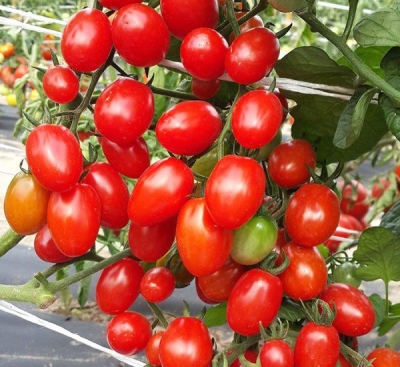
- Category: hybrid
- Growth type: determinant
- Appointment: universal
- Ripening period: early
- Ripening time, days: 95-100
- Growing conditions: for open field, pot culture
- Transportability: high
- Bush size: undersized
- Bush height, cm: 50-70
- Ripe fruit color: Red
Tomato is one of the most popular vegetables on the table among Russians. However, not many have the opportunity to grow a plant on the site. The Siberian date tomato is a compact crop that can be planted even on the balcony in a garden pots. The variety is very productive, the bushes are strewn with a huge number of small delicious fruits with minimal effort.
Description of the variety
The Siberian date belongs to the determinant varieties, the height is small 50-70 cm. The plant is decorative, covered with small green leaves, therefore it is often used for landscaping and beautification of the site. Compact shrubs can be grown outdoors, but can also be used as a potting crop.
The pluses include:
early ripening;
high productivity;
universal purpose;
frost resistance;
excellent keeping quality, the harvested crop lasts about 2 months without losing its taste;
strong immunity;
prolonged fruiting;
you do not need to tie up and pinch.
Among the cons:
the plant is a hybrid, so you won't be able to get planting material on your own;
For best yields, the tomato is best planted in a sunny location.
The main qualities of the fruit
The hybrid bears fruit with small tomatoes. The maximum weight of one fruit is not more than 20 grams. The shape is elongated, plum-like, with a pointed tip. Fully ripe tomatoes are bright red. The skin is firm, protecting the fruit from cracking. They are easy to store and transport. The variety is excellent for growing on an industrial scale.
Taste characteristics
Siberian date is a very tasty hybrid. Small and sweet fruits have a sweet gourmet taste, with a delicate tomato aroma. The pulp is juicy. Tomatoes are often used to decorate ready-made dishes, put in salads, dried, and canned whole. It is widely used in baby and diet food.
Ripening and fruiting
Ripening is very early, tomatoes begin to ripen 95-100 days after the first shoots appear. The fruiting period is long. The first fruits can be enjoyed in June. Harvest until September.
Yield
The plant is high-yielding. 6-8 fruits ripen on one bunch. 4-5 kg of tomatoes are harvested from one square meter.
The timing of planting seedlings and planting in the ground
Seeds begin to be sown for seedlings in April. Before proceeding directly to planting seeds, they should be disinfected, treated with a special agent to stimulate development. For better growth, it is advisable to use ready-made storey soil.
To get strong seedlings, you need to properly care for it. Until the seeds have germinated, they must be kept covered in a warm room at a temperature of 18-21 degrees. When 2-3 full-fledged leaves appear on the plant, they begin to dive. 7-10 days before transplanting to a permanent place, the seedlings are hardened.
Seedlings are planted in a permanent place at the age of 40-50 days. As a rule, the procedure is carried out at the beginning of June.

Growing tomato seedlings is an extremely important process, because it largely depends on whether the gardener will be able to harvest at all.All aspects must be taken into account, from seedbed preparation to planting in the ground.
Landing scheme
The culture must receive a lot of oxygen and a sufficient amount of nutrients. Therefore, 1 sq. m, you can place no more than 5 bushes. Tomatoes are planted in the soil according to the 50x40 centimeters scheme.

Growing and care
The culture is easy to care for. The Siberian date tomato does not need pinching and garter, which significantly saves time. And also the plant does not require shaping of the stems. The tomato stops growing at 8-12 inflorescences.
Before proceeding with the transplant to a permanent place, the site is pre-prepared. To do this, the soil is dug up, weeds and debris are removed, and organic fertilizers are applied. The holes are shallow, the seedlings are carefully deepened, tamped and watered abundantly.
Until the seedlings take root, they are left alone. Do not water or loosen the soil. When young leaves begin to appear on them, they begin the main activities for caring for tomatoes. The soil is preferable to use fertile, breathable.
The tomato responds positively to the applied fertilizing, both mineral and organic. First, the bushes need nitrogen to gain vegetative mass. With the emergence of peduncles, they need phosphorus and potassium in order for the ovaries to be numerous.
Watering is moderate, as the earthen coma dries. It is best to use drip irrigation. The soil will be moist, but not waterlogged or overdried.




A plant needs different micronutrients at each stage of growth. All fertilizers can be divided into two groups: mineral and organic. Folk remedies are often used: iodine, yeast, bird droppings, eggshells.
It is important to observe the rate and period of feeding. This also applies to folk remedies and organic fertilizers.
Disease and pest resistance
Breeders sought to create a fairly resistant variety to diseases, especially late blight.


Review overview
There are not many customer responses about the hybrid. But they all note excellent taste, an easy care process and high yield rates. Among the disadvantages, consumers note the high cost of seeds, of which there are no more than 10 pieces in a package.

























































































